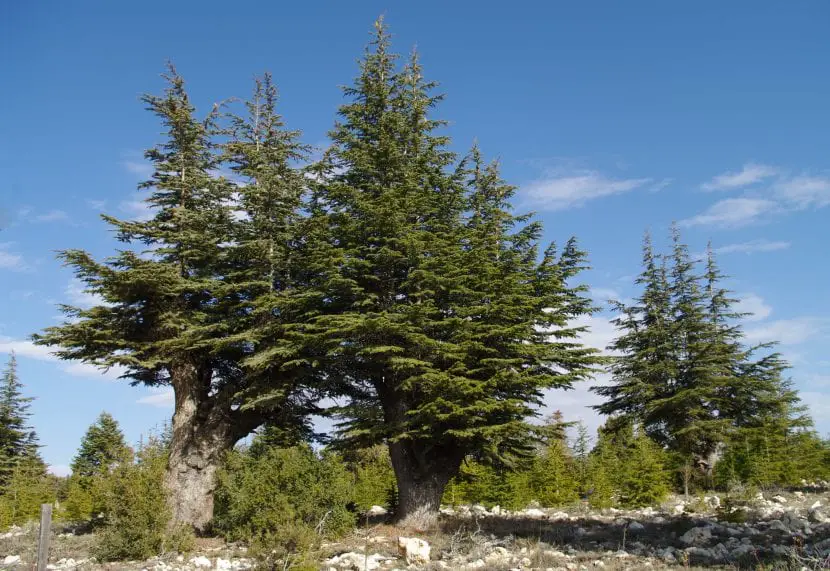
Image – Wikipedia, the free encyclopedia
Many people do not want to plant conifers in their gardens because they have roots that can cause problems, or because their growth rate is too slow. And, I am not going to fool anyone: reason is not lacking. But if you have a medium or large lot, give a hole to a tree like the cedar of Lebanon it’s a great decision.
The reasons are various. For example, you should know that it resists very strong frosts, that it loves the mountain climate and, yes, it also has curiosities that I will tell you at the end of this article. Know more… .
Origin and characteristics

Image – Flickr / Juan_Sanchez
Known as Solomon’s cedar or Lebanon cedar, and whose scientific name is cedar, this is an evergreen tree native to the Mediterranean mountains between 1300 and 1800 meters above sea level, in Lebanon, western Syria and south central Turkey.
It is characterized by reach a height of 40 meters or morewith a thick trunk towards the lower part, and with a crown formed by branches spread horizontally, although when young it can adopt a more pyramidal appearance, especially if it grows in a dense forest or in a wooded garden (one that tries to imitate to the aforementioned). The leaves are acicular, green and rigid. These remain in the conifer for several months or years before falling; and still, you will see it always green because they do not all fall at the same time.
The cones are sphericalabout 7 to 10 centimeters in length, and inside they contain various seeds that germinate easily in spring.
What is the care of the cedar of Lebanon?
It is not very difficult, and if you dare to buy one, it is more than likely that you will enjoy it a lot. But … if you do not want problems to arise, we recommend providing the following care:
Location
It is a plant that must be abroadin full sun or in semi-shade. In case you live in an area with strong sunshine, it is better to have it protected from the sun king.
Earth
- the garden: it is quite adaptable, but it prefers light, cool and not too humid soils. Tolerates limestone.
- Flower pot: It is not a tree that can be in a pot for many years, but if you want to grow it in one during its youth, fill it with universal substrate (for sale here!).
Irrigation
During the summer you will have to water very oftenabout 3 times a week, but the rest of the year and especially in winter irrigation will be rather scarce (1 or 2 times a week).
Use rainwater whenever you can. If you can’t get it, use the bottled one, or fill a container with tap water and let it sit overnight so the next day you can use the water from the upper half, which is the one that will have the least heavy residue.

Related article:
Types of water to water plants
Subscriber

Image – Wikimedia Commons / Cruiser
Throughout the spring and summer it will be highly recommended to fertilize the cedar of Lebanon. For this you can use organic fertilizers such as guano (for sale here!), bone meal (for sale here!), or worm castings (for sale here!), among others; or compound fertilizers such as universal fertilizer (for sale here!).
Just keep in mind that it is necessary to read and follow the instructions specified on the packaging to avoid the risk of overdose (especially if you opt for chemical fertilizers).
Multiplication
It is a tree that multiplies by seeds in winter. As soon as you collect the ripe cones, you have to open them, extract the seeds and sow them in pots of about 13cm in diameter or in seedling trays with universal substrate. You bury them a little so that they are not exposed directly to the sun, water and place the pot or tray outside, in semi-shade.
Keeping the substrate moist they will germinate throughout the spring. Feel free to sprinkle copper or sulfur when the flower season approaches and you will avoid the appearance of fungi, which could spoil the seeds (and also the substrate).
Pruning
Don’t need it. Cut off dry, diseased or weak branches in late winter, but nothing else.
Diseases and pests
It does not have 🙂.
Planting or transplanting time
In early spring, when the risk of frost has passed.
Rusticity
It resists frosts of up to -18ºC.
What uses is it given?

cedar in the center, with magnolia kobus (left) and Prunus x yedoensis f. balancing // Image – Flickr / Tie Guy
- Ornamental: it is a very decorative conifer, which looks great as an isolated specimen, in groups or in alignments. It can also be worked as a bonsai.
- Wood: it is considered one of the heaviest, dense, strong, durable and aromatic in the world. With it, furniture of all kinds are built: tables, desks, chairs, etc.
Curiosities of the cedar of Lebanon
It is a very important species for Lebanon, not in vain, it is its emblem. Likewise, the wood from this plant was used by King Solomon to erect his temple. And as if that were not enough, the carpentry of the temple of Ephesus also comes from this conifer.
What did you think of this conifer?

